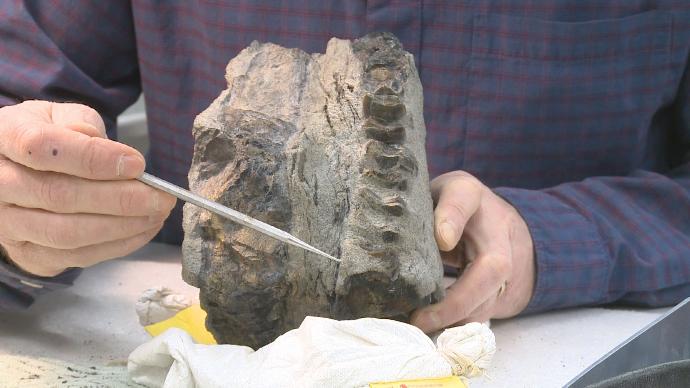@WFS,World Fossil Society,Riffin T Sajeev,Russel T Sajeev
A beach can be a place of discovery. Broken shells, whimsical weathered bits of wood, flotsam from a foreign corner of the globe. You never know what treasure you might find.
In July of 2017, the Reising family of Seward, Alaska was enjoying a picnic lunch on a popular beach near Homer, Alaska, taking a break from a favorite hobby, beachcombing.
“We were looking for plant fossils,” said Kai Reising. He was five years old at the time and running late for lunch. As he joined the rest of his family, he spotted a rock almost under his Dad’s feet. “It looked like a piece of petrified wood and I picked it up,” he recalled.
It was a bread loaf-sized piece of brown sandstone. Kai thought it was interesting, so he passed it to his dad for a second opinion. George Reising, Kai’s father, is a science and math teacher at Seward High School. “We flipped it over and right on the bottom were all these teeth,” George Reising said.
Kai’s mom, Deb Klien, is a biologist. She homeschools Kai and his younger brother Silas. “We just had a lot of fun speculating on what it might be,” she said. That’s when everyone got excited– making guesses as to what type of animal Kai’s find might be.
On their way home to Seward, they stopped by a rock shop in Sterling, Alaska for an additional opinion. It was pointed out that there was coal present in the sandstone. That’s when George Reising knew what they had found was about 10 million years old. “All of our lights went on. And we said, wait a minute, this is not Pleistocene at all. This is something significant. Nothing in the record,” George Reising said.
Dr. Patrick Druckenmiller, Director of the University of Alaska Museum of the North in Fairbanks, explains why there would be something new to Alaska’s fossil record. “We have dinosaur fossils in Alaska up to about 69-70 million years ago. And we have ice age mammal fossils in Alaska about just several thousand years old. And in between is a big gap that we have almost nothing in terms of fossil vertebrates.”
The Reisings had met Druckenmiller on a trip to Fairbanks they made earlier in the year. So they sent him some pictures of the fossil. When he saw the pictures, his heart rate went up. “This was something we had never seen before,” Druckenmiller said. A hand-off of the rock was arranged and a basic identification of what had been found quickly followed. “These teeth are very distinctly Tapir Teeth,” Druckenmiller said.
Tapirs can still be found in some parts of South America but they are a fraction of the size of their fossilized cousin. “This is the first evidence of this group of animals ever found in the state of Alaska,” Druckenmiller said. He thinks it is possible this might even be a new species.
A dark spot on the fossil offers an important clue to Druckenmiller. “It is very clearly a fresh break and this is probably right where this was attached to more of the skull in the side of the hill before it weathered out and tumbled down the bluff.”
That speculation prompted a trip back to the Homer beach this past summer. Hopes were high of finding additional pieces of the Tapir. But a group of scientists couldn’t duplicate the luck of a 5-year-old boy and no other pieces were found.
Druckenmiller wasn’t surprised this important fossil was found by a family on a picnic. “A lot of major fossil finds, whether they be dinosaurs or mammals or whatever, they’re not made by professional paleontologists,” he said. “They’re made by people out walking on the beach or out hunting or out fishing… because they are out in a place people don’t normally go.”
Also, he adds, “Five-year-olds are a lot closer to the ground.”
Druckenmiller wants to remind people that fossils found on state land are property of the state. He says, if you find something interesting, you can help by taking lots of pictures of the find and of the area. And if possible, note the GPS coordinates.
Source: www.ktuu.com
@WFS,World Fossil Society,Riffin T Sajeev,Russel T Sajeev



 March 19th, 2019
March 19th, 2019  Riffin
Riffin 
 Posted in
Posted in  Tags:
Tags: 